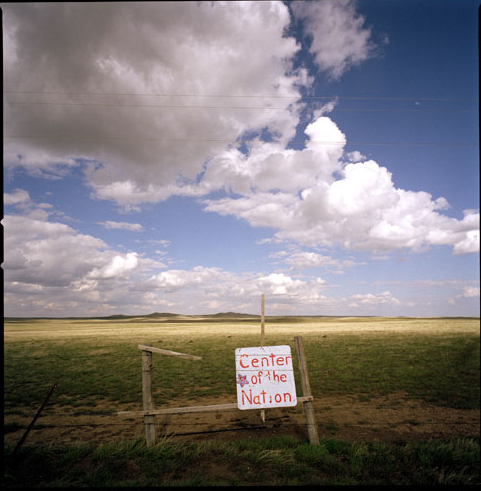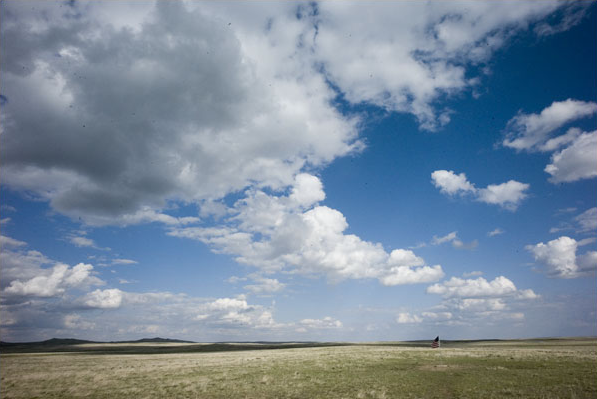The New York Times ran a story yesterday entitled “In the Middle of Nowhere, a Nation’s Center.” The subject was the geographical center of the U.S., which is a windswept prairie in Butte County, South Dakota.
There is a monument, of course, but it’s in the nearby town of Belle Fourche. Most visitors–yes, there are visitors–are content to take their pictures there rather than trek out to the actual spot. The reporter’s sense of irony is light, in keeping with his respectful attitude toward the folks actually living there. The story even includes a feel-good ending. “But then, in this remote, still place, there comes a strange sense of reassurance: that in this time of uncertain war and near-certain recession, of home foreclosures and gas at $4 a gallon, at least somewhere in this nation a center holds.”
But does it hold? Or, more to the point, why would it not hold when no one wants a piece of it? And isn’t the scene pathetic? The abandoned landscape reduced to flee market status by the hand-scrawled sign? The Times story provides an inadvertent chronicle of how rural America, once vying for its place in the nation’s prosperity, has been bypassed for roads leading elsewhere. And let me add that $4 a gallon gas hurts them a lot more than it hurts you. But you already are accustomed to not seeing them, and there are no pictures of people in the slide show accompanying the story. All you have to do to complete efface the unpleasant fact that people still live there is remove the sign.
This is another photo from the slide show, and the last of the set. Now we have a classic shot of America the Beautiful, the mythic landscape of the American West and its message of endless possibility. That image was already in the first photo, but there it sets up the irony of the ragged sign, which in turn changes the magnificent vista into a desolate “moonscape.” Ironically, the sign declaring a center highlights its emptiness. When that emptiness is not marked by the visual excess of a verbal text obviously added to the scene, a tawdry bit of culture marring nature’s grandeur, then one can see fullness, a richly symbolic affirmation of national potential. Like the wind, endless, waiting to be harvested.
Or, like the sign, symbolic in another sense. With his assurance that “at least somewhere in this nation a center holds” the reporter offers a refutation of W.B. Yeat’s famous indictment of modernity in “The Second Coming.” But the center in question is not holding, not in South Dakota, anyway. Agribusiness, agricultural policies, transportation policies, and other very real historical forces are draining the land of people, soil, water, you name it. America has invested heavily in centrifugal processes, and seems to have little time to be centered, much less balanced, reflective, or attentive to its own.
Photographs by Angel Franco/New York Times. For another perspective on the Great Plains and what one can learn there about being centered, see the wonderful book Dakota: A Spiritual Geography by Kathleen Norris.


I don’t see the first picture as a pathetic scene. It is lovely, serene and almost unspoiled. Not abandoned but granted a reprieve. And the sign is a fitting monument to it’s real importance. But it is also a highly symbolic picture to me. The center is empty in an America that is drifting toward extremes, extreme liberalism and conservativism, extreme wealth and poverty, extreme hedonism and self involvement. I guess it’s like a Rorschach test. What we see tells us more about us than about the picture itself.
I agree with the previous poster – I don’t find the first image pathetic. I find it quite refreshing that even in the US, the centre point is marked with just a home-made sign.
As an aside, there’s actually a comparative situation with the Equator in a country named it: Ecuador. There is a large equatorial monument just outside the capital city, Quito, complete with small museum, restaurants, souvenir stalls, etc. You can have the all-important photo taken with one leg each side of the line. Only trouble is, the real equator is several hundred metres away. Just up the road on the ‘real’ equator, there is a smaller tourist attraction where you can do the equatorial tricks like seeing the water going straight down the plughole and balancing an egg on the head of a nail.
The Center Holds
I write this from a spot about 200 yards south of the ersatz Center of the Nation monument in the city of Belle Fourche. I am a life-long resident of this area; I can even claim to represent the area as a fourth-generation old-timer. (My great grandfather trailed cattle from Texas to the Dakota’s, and liked the area so much that he homesteaded here.)
From this point of authority, I can tell you that the sign isn’t “pathetic”; is is simply someone’s attempt to “mark the spot”. It wasn’t any government or even civic group that made the sign; it is more of a local note of congratulation that signifies that yes indeed, you have persevered until you found the spot.
The phrase “abandoned landscape reduced to flee market status” is patently stupid: the landscape was never productive enough to be claimed for more than pasture and so is not “abandoned”. Thousands of square miles look much the same, without the distinction of being a “Center”. And exactly what would be wrong with marketing the center? Nothing is more American than selling a commodity, whether it is nearly pristine open prairie or a perceived “center”.
And no, the center is not empty. We are Americans who go to work every day, pay taxes, worship our God, and raise families. Some of us do better than others, some are happy and others just satisfied. There are those who appreciate the natural beauty around us, and others who do not. In the end, we’re pretty much like everyone else, except that we can brag about living at the Center of the Nation.
Paul: Thank you for your eloquent comment. I think I have been misunderstood, for which I am to blame. To provide a bit of background, I grew up in North Dakota and my parents still live there. I have written several posts for this blog that celebrate life on the Great Plains. I would like to think that if you set aside my use of the word “pathetic” and read the rest of the comments, you can see how I am suggesting that the people living in Dakota have nothing to apologize for. I was trying to suggest that there is something disingenuous about the New York Times coverage: in an urban society, many people really don’t care much about life in “fly over country” except as it can represent their sense of a mythic America. I assumed that the sign was displayed in the paper because it looked forlorn, pathetic, or something like that–a long way from the St. Louis Arch, for example, much less the Statue of Liberty. And the second picture is there to suggest that many people prefer to think of the Great Plains and the West as if no one actually lived there. Or consider how someone can feel good because the “center holds” during a time of $4 a gallon gas, without thinking for a minute how that price hits rural America. I was writing as I did because I believe that the county does not care as it should about the land and the people living there.
[…] to our readers: I posted on Belle Fourche recently, and this second post is something of an atonement for a mistake made at […]
Hariman: Thank you so much for your clarification; your “When is a Flag..” post is also perfectly to the point.
We may be forgotten, ignored, and even disregarded to our detriment by a majority of people on the coasts; but the small minority who appreciate, come to visit, and even wish to sustain the character of the Dakotas, are important to us. Being underappreciated usually seems a small price to pay for the ready availability of solitude and the grandeur of nature.
Spending a day hiking in remote areas of the Black Hills, or better yet in the prairie grasslands or really remote spots of Custer National Forest (Harding County, SD) can focus one’s mind. While sitting listening to the wind, under a huge blue sky in almost complete isolation from other people, the distinctions of “liberal” and “conservative” start to blur and the idea of what it means to just be human can take on more importance. Even $4 gas sounds good compared to original settlers who were worried about keeping their remaining oxen healthy enough to pull the wagons and measured progress in miles per day.
[…] lignes jusqu’à remplir tout l’espace disponible (ce qui ne veut en rien dire que le centre du pays ne soit pas […]
As a Belle Fourche native and also the designer of the Center of the Nation monument, I felt the New York Times article was pretty good – entertaining, but predictably glib. I find it funny that in the headline the United State is being called Nowhere.
And I actually struggled with Yeats The Second Coming while preparing the design. Why celebrate the center of something which many feel is clearly fractured and disintegrating? In the end, I decided that it should be about celebrating perseverance, hope, inspiration, the quest for love and truth and knowing that you are at the heart of something great. Basically all things that because we value them make the Yeats poem so effectively creepy.
I really enjoy the various perspectives about what truth is offered by a painted sign at the center of the nation. I especially appreciate Paul Turbiville’s comments. I would like to point out that the remote location is merely the center of like a 50 mile zone, that somewhere within is the geographic center. Belle Fourche could just as likely be the center as the Deer’s Ears Buttes (where I think may have been the zone center before Hawaii was added.) What does that say about our nation?
I like the picture. The true sight is located on farmland north of Belle Fourche. Belle Fourche is french for beautiful forks. The monument of the Center of the nation is located along the Belle Fourche River. It’s about a quarter mile upstream of the forks. Come visit us in The Mount Rushmore State.